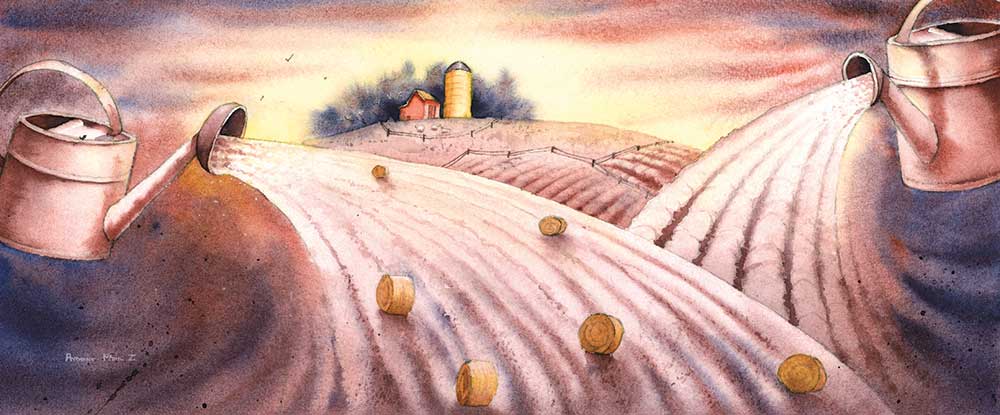Links in the (Food) Chain
Non-Profits Help Grow a New Generation of Farmers
By Kandy Harris | Illustration by Anthony Pfohl Jr. | Winter 2014 | Farm & Garden
Farming is big business in the Hudson Valley and Catskills. There are over 2,000 farms and 400,000 acres of farmland in the Catskill Mountains alone, reportedly earning $300-$400 million annually. Agriculture is the economic backbone of upstate New York, whether for small organic farmers hocking their eggplants at farmers’ markets or larger operations wholesaling to New York City restaurants.
But that doesn’t mean that keeping the agricultural industry alive upstate isn’t a rough row to hoe (so to speak). According to American Farmland Trust, a farmland conservation organization, almost a third of Hudson Valley farms are run by farmers over the age of 65, many of them without descendants willing or able to take over the family business. For those members of the younger generations who do want to venture into the farm fields, a number of challenges face them, from access to land and capital, to equipment, education and labor. Finally, development pressures continue to make farmland appetizing to real estate eyes.
“You have this demand for high-quality, fresh, naturally grown food from local and regional markets, as well as downstate markets in New York City,” says Beth Forster, Farm to Market Manager at the Walton, NY-based Watershed Agricultural Council, which assists farm and forest land owners to help protect the New York City watershed. “It creates an economic opportunity, but to meet that demand that we need farms and we need farmers.”
That’s why, in 2010, the Council got a grant from Farmhearts, an organization that is “committed to lending a hand to the hands that feed us,” according to their mission statement, to create Catskills FarmLink. It’s a kind of dating service for farmers looking for land and landowners looking for someone to farm their properties. Landowners can advertise their property in the site’s Land Listings section, where those interested in farming shop around.
The math is pretty simple. “There are so many dairy farms that are aging and may or may not have someone in the family who wants to take over,” says Forster. “And we have a lot of second homeowners who can get a tax break if their land is farmed.” Meanwhile, there’s a modern back-to-the-land movement among Milennials and Generation X: They have the will, but not the land.
FarmLink’s mission is to “promote the Catskills as a great place to operate a small, diversified farm,” according to their website, which entails a multifaceted approach. They don’t just connect farmers to land; they support them by way of sharing resources. On the site are farming guides, with educational documents about soil and climate considerations, financing, and farm infrastructure. Catskills Farmlink aggregates and shares business plans and grant opportunities. There are guides for landowners on leasing issues and sustainability.
At the time of this writing, there were around 50 land listings on the site, in all seven counties that touch the watershed itself: Delaware, Greene, Ostego, Schoharie, Sullivan and Ulster, representing hundreds, if not thousands, of available acres.
But availability doesn’t equal ease of access, which is why linking tenants to landowners is so important. “If we’re talking about somebody who doesn’t have any credit, is only a few years out of college, isn’t established in any sense, then a mortgage is out of the question,” says Eleanor Blakeslee, a farmer herself who administers the FarmLink website. “FarmLink is set up so they can lease land or come up with creative arrangements for accessing land.” Blakeslee also suggests that newbies use the site to find a farm to work on before venturing out of their own.
Catskills FarmLink isn’t the only upstate group trying to preserve farmland and attract a new generation of growers. A site with a similar mission, Hudson Valley Farm Finder, helps farmers and farm-owners find each other in other parts of the Valley, like Orange, Albany and Washington Counties. Catskills CRAFT (Collaborative Regional Alliance for Farmer Training) works with Farmhearts, Pure Catskills (a “buy local” campaign and resource guide), and the Watershed Agricultural Council to prepare new farmers for the industry, providing knowledge that gets lost when children don’t take over the farm from their parents.
Catskills FarmLink’s impact is modest, but growing. There have been two official links so far. Tuff-a-Nuff Farm in Walton found 500 acres of land through Catskills FarmLink, and 10 acres of fallow land with its own farm stand in the Ulster County hamlet of Mount Tremper was rented through the Catskills FarmLink Land Listings page. Forster says there is e-mail every week from folks who are already farmers in spirit, if not in practice.
They ask her things like if the land is still available, if she can connect them with the owners, how the quality of the soil is and if there’s a barn or a living post. What they get in response is often a list of questions themselves. “Because there are so many factors that go into successful farming, you really have to ask them what kind of farming they plan to do. Some land is more suitable for livestock; some is better suited for growing things.”
Perhaps most importantly, FarmLink asks potential farmers about their marketing channel—how are they planning to sell what they grow or raise. Farmers’ markets? Wholesale to the city? Their own farm stand? “We ask what they want to grow and how they want to sell it,” Forster says, “and that can help you understand if a piece of land is right.”

[…] the way, the Catskills are moving and shaking in the agricultural world, as well. Read more about that in the most recent issue of Upstate […]